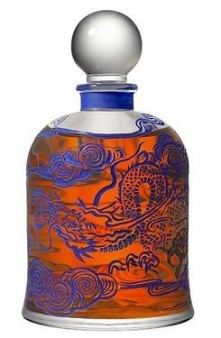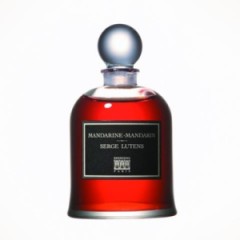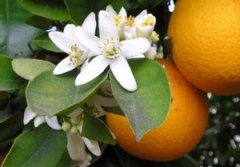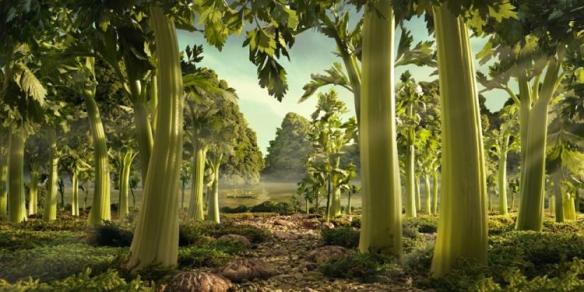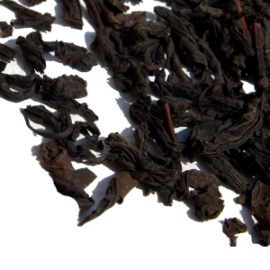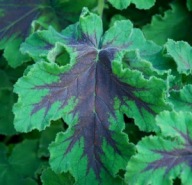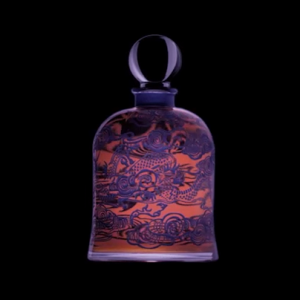I thought I’d start my Serge Lutens series of reviews with a perfume that captured my imagination a long time ago. Mandarine Mandarin intrigued me not only because I adore orange notes but, to be perfectly honest, for an incredibly shallow reason: the bottle. I saw a photo of the special, limited-edition, now impossible to find, “Dragon” bell jar for Mandarine Mandarin on Serge Lutens’ Facebook page, and that was that. I rarely care a lot about packaging, but that bottle had my jaw on the ground. Even though Mandarine Mandarin now comes in the ordinary, plain, glass bell jar form, I decided that I had to try it. The fact that the perfume seems to be a call-back to Imperial China (one of my favorite areas of history), and the fact that no-one ever talks about it simply cemented the deal.
Mandarine Mandarin was released in 2006, and is the creation of the always brilliant Christopher Sheldrake. Although it is one of the Paris Exclusives in a bell jar form, it can actually be purchased outside of France, either from Barney’s New York or directly from Serge Lutens’ international and U.S. websites, though it’s always at a big mark-up if you are buying outside of France.
The Lutens website gives a brief synopsis which, in my opinion, creepily calls to mind chicken feet and claws:
Tiny feet and long nails may be things of the past, but the odor of peeled mandarin oranges is forever.
Suddenly the fragrance comes back to me. As a child, I would place the peel on a hot burner of the stove, rendering a scent I’ll never forget.
As always Uncle Serge refuses to give the notes for the fragrance, so we must engage in the typical guessing game. According to Bois de Jasmin, Fragrantica, and elsewhere, the most commonly accepted list of ingredients seems to be:
Chinese orange, nutmeg, candied mandarin, orange peel, smoky Lapsang tea, labdanum, tonka bean, ambergris, and rose hip.
There is no way that list is complete, in my opinion, especially given one note that was a big part of the first two hours of the fragrance and which left me blinking in slack-jawed disbelief before making me laugh with confused amazement.
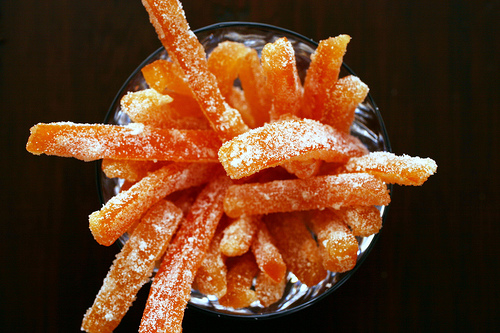
Source: broadsheet.com.au and the smittenkitchen.com, via flickr. http://www.flickr.com/photos/smitten/2231161820/
Mandarine Mandarin opens on my skin with candied orange peel, the blackest of smoky Lapsang Souchong, sweet orange blossom florals turned spicy, and cold, green notes. Then, within seconds, comes the shock. Celery. Yes, I said celery. To be precise: badly overcooked, highly concentrated, boiled celery. It’s not just a tinge, it’s not just a subtle, background flicker, and it’s not fresh, light, bright, green celery. It’s full-on, hardcore, intense, overcooked, yellowing celery. I can’t figure out what is the cause of it. Angelica often has a strong undertone of celery, but I’ve never smelled angelica quite like this. This note seems different, and much like actual, cooked celery purée. But would Serge Lutens and Christopher Sheldrake use celery concentrate in what is supposed to be a floral-oriental perfume?? On second thought, never mind. It’s Lutens and Sheldrake; they probably would do so with a grin….
Making matters even more disconcerting here, the boiled celery is mixed with an equally potent orange blossom note that is sweet, almost syrupy, and intensely white floral in nature. It’s as if cooked vegetables have been mixed with Fracas or Mademoiselle Piguet. Lurking close-by is candied, lightly caramelized orange, studded with spices. The whole thing is beautifully smoked with the most entrancing black tea that feels as if you’ve taken bags of Lapsang Souchong and tossed it in a fireplace. When I can get my mind off the boiled celery, I truly enjoy the other accords, but… damn. That celery. Even stranger is how spiced the vegetable is; I find myself waiting for a curry note to go with it. Thankfully, that doesn’t happen (though it did for someone on Fragrantica), but, still, there is no doubt that the food aspect is hard to shake.
The orange note in Mandarine Mandarin is interesting. Whatever the notes may say, my nose doesn’t detect a hell of a lot of the actual mandarin or orange fruit. The note isn’t juicy, pulpy, zesty, zingy or fresh; it’s nothing like either orange juice, or the pulpy fruit itself. Instead, it’s a mixture of the white flowers of the tree, with a dash of the slightly bitter oil of grated orange peel, and a whopping amount of candied oranges highly spiced with bitter nutmeg and spicy star anise. There is, in fact, a rather aniseed nuance to the odd, green element in Mandarine Mandarin, and it evokes tarragon at times. I find myself completely bewildered by the odd combinations, while somewhat in awe of Christopher Sheldrake’s brilliantly original madness. You can never say that Serge Lutens fragrances are boring, that’s for sure!
Mandarine Mandarin doesn’t change much in its opening stage. Thirty minutes in, the boiled vegetable, spiced fruit, and heady, indolic, white florals continue their mad march, seemingly gaining in potency and strength. The orange visuals — the way they so forcefully and militantly march, and the slowly growing amber aura around them — make me think of the famous Terracotta Warriors that I saw in China. I think it’s because of the amber base which, by the end of the first hour, is increasingly prominent. It becomes sweeter, darker, denser, taking on a sticky, burnt caramel nuance. At this point, I’m simply laughing. I mean, what are you supposed to do when you’re radiating boiled celery, clove-nutmeg-infused oranges, burnt orange peels, smoky Lapsang Souchong black tea, Fracas-like white florals, and burnt caramel?!
Thankfully, Mandarine Mandarin eventually starts to lose some of its forcefulness, and softens. At the 90-minute mark (but most definitely at the two-hour one), the perfume becomes a smoother, more blended, warmer, gentler mélange of orange, black, and green notes that aren’t as individually distinct as they were before. The smokiness is less sharp, though the black tea impression remains strong, and the sticky caramel feels merely like abstract, syrupy, burnt balsam resins. Interestingly, the base note never reflects the usual facets of labdanum. It’s not leathery, honeyed or nutty. Instead, there is a slightly sharp muskiness that — if you really push it — may possibly feel a little animalistic. If you really strain yourself, then, perhaps, it borders almost on leathery, but not quite. Like everything else, however, it is covered by orange blossoms and boiled celery. (I’m having a really hard time writing all of this with a straight face.)
Something about the vegetal-orange-blossom combination really reminds me of an all-natural bug spray I have that is made of geranium oil, cedar oil, clove oil, tarragon, and other green herbs. Mandarine Mandarin has the same sort of powerful, floral, herbal, green sharpness. Moreover, as time passes, the perfume’s celery note gradually fades away to be replaced by something that smells very much like geranium’s green, fuzzy leaves.
By the middle of the third hour, Mandarine Mandarin’s primary bouquet is of slightly burnt, caramelized, candied oranges and sweet orange blossoms, followed closely by smoky Lapsang Souchong black tea, and that strange green note that now smells of geranium leaves. Underneath lurks the slightly musky, burnt labdanum caramel, burnt orange peel, cloves, the merest hint of bitter nutmeg, and some abstract amber element.
As time ticks on, Mandarine Mandarin becomes increasingly nebulous and abstract in form. All the notes have taken on a blurry aspect in the drydown, fading in definition and distinctness, and melting into one overall bouquet that is primarily dominated by amber and a floral orange with flickers of black smokiness. The perfume started being closer to the skin around the third hour, but it becomes more so with every passing hour. Though the drydown has begun, it takes a lot more hours for Mandarine Mandarin to fade away as a simple, amorphous, sweet orange note with some muskiness.
All in all, the perfume lasted 8.75 hours on my perfume-consuming skin, though I was in cool temperatures for much of it and that may have made a small difference and extended its life. The moderate sillage was interesting because Mandarine Mandarin isn’t a perfume that you can smell across the room. Yet, within its small cloud, it is very intense, especially at first. After the first hour, it hovered about 3 inches above the skin, still forceful up close, until the start of the third hour when it suddenly softened and dropped. Nonetheless, the fragrance is easily detected for another few hours if you bring your arm somewhat close to your nose.
One of the reasons why I had wanted to try Mandarine Mandarin is because you never hear about it. I couldn’t understand that, but I knew it couldn’t be an issue of exclusivity or access. After all, people talk endlessly about other Lutens’ bell jar fragrances from Sarrasins to Fumerie Turque, La Myrrhe, Iris Silver Mist, and so on. Now, however, I get it. Mandarine Mandarin is just too weird, especially in light of the cost. Out of 15 reviews on Fragrantica, nine of them mention celery and/or vegetables. Nine! One commentator summed things up succinctly as: “All I can smell is mandarin celery, not for me.”
With one exception, those few blog reviews of Mandarine Mandarin that are out there never mention the celery. Bois de Jasmin doesn’t, and neither does The Perfume Posse or The Perfume Shrine, though the latter does make some reference to rotting fruit (and death). To me, most reviews seem ambivalent and somewhat unenthused in their response to the scent, as if they just want to get the discussion over with. To be fair, the Perfume Posse is more positive, writing:
When first applied, I get a lot of the orange notes, but there is nothing sweet or citrusy about this after it’s been on a bit. The orange becomes a whisper, hidden behind the darker elements in this perfume. It’s like being in a dark house that is warm and comforting, with a little cold breeze and one ray of sunshine coming through the window and hitting the floor.
As much as I did NOT like Chypre Rouge, it just went bad on me, Mandarine-Mandarin is everything I wanted Chypre Rouge to be, though they aren’t the same in composition — just the feel of MM is what I wanted CR to be. It’s at once bitter and a little sweet, dark and a little light. Definitely unisex, complex and constantly changing while retaining the tension between the notes. It’s a great composition, shadows of notes constantly shifting in contrast to each other.
When I went by my husband after spritzing on a cloud of this, he really liked it, and he doesn’t notice many perfumes I wear.
A truly appreciative review of Mandarine Mandarin comes from Perfume-Smellin’ Things which is the only blog to actually mention the cooked celery aspect — and still like the perfume:
It is dark, sweet, and as complex and mysterious as I like Lutens’s scents to be.
Mandarine Mandarin goes on my skin through three very distinctive stages. It starts with a sweet citrusy-floral accord. I smell honeyed orange blossom, over-ripe mandarins and oranges. A slightly green and softly smoky/spicy note is woven into the citrusy sweetness preventing it from being completely jam-like. As time passes, the citrus accord subsides and the green-spicy aspect grows stronger, and we are suddenly presented with stage two, which, although as sweet as the first one, is much darker, much more substantial, much stranger than only slightly quirky top notes. Here I smell the remains of orange blossom, strongly brewed Lapsang Souchong, a rose that is as black as the night, lots and lots of smoky honey and an ingredient that seems to be a hybrid of celery and immortelle. It has the bright, crunchy greenness of the former and the spicy meatiness of the latter. It is odd, it is somewhat out of place in a blend called Mandarine Mandarin, and it makes the scent unmistakably and very appealingly “Lutens”. This dark-sweet-spicy-meaty stage lasts for a long time, perhaps 5-6 hours at least, before evolving into the drydown that is much more subtle then the rest of the scent. This final stage witnesses the return of citruses, it has a slight herbal undertone and a general cologne-like feel.
Mandarine Mandarin is to me Lutens at his best. It is a strangely-beautiful perfume with rich “texture”, depth and complexity. I like it a lot. It isn’t one of my most beloved Lutens perfumes (although it is too early to tell, his scents have a tendency to sneak up on me and suddenly madly infatuate me) and I am not sure yet if I want to jump through the hoops trying to obtain the bell jar…but I cannot help but admire it’s tasteful, sophisticated opulence.
I adore everything about Serge Lutens, from his extremely well-read intellectualism, to the complexity of his fragrances with the genius who is Christopher Sheldrake. I’m in awe of their originality and sophistication, of how they’re never boring, and of how they try to stretch the bounds of perfumery. I’m fascinated by how they often deconstruct an ingredient, then reassemble the pieces back together as something wholly different, as in the case of the tuberose flower in Tubereuse Criminelle. They’re both mad scientists in the olfactory field, but what is perhaps the best part of all is how their perfumes often seem more like living things. They morph, breathe, and change like sinewy creatures in the most sophisticated of skins.
But I can’t wear Mandarine Mandarin. No matter how much I love orange notes, orange blossoms, labdanum, resins, and the uncommon addition of Lapsang Souchong, I simply can’t do it. No way. Between the super intense, cooked celery, and the bug-spray feel of the floral-geranium-clove accord during the middle stage, I found the scent simply too difficult to pull off in any practical sense, let alone to wear on a daily or weekly basis. Most of my regular readers know how rarely I agree with Luca Turin but, in this case, he’s completely right. In Perfumes: the A-Z Guide, his short, two-star review of Mandarine Mandarin essentially boils down to this summation: “Deeply strange, quite intense, and not particularly wearable.”
If I could get my hands on that rare, limited-edition “Dragon” bell jar of Mandarine Mandarin — and if I could hypothetically afford what is undoubtedly now an outrageously expensive collector’s item — I’d buy it. But to fill it with something else. I really don’t want to smell of “vegetable soup,” “mandarin celery,” “straight celery,” or even “background” celery mixed with burnt orange peel and bitter nutmeg.
Yet, despite all that, if you’re really intrigued by the notes in the perfume, I’d encourage you to get a sample. After all, there have been some who had success with the fragrance, so maybe you have the skin chemistry to pull it off. At the very least, you’ll have quite a stimulating, original, crazy ride!

